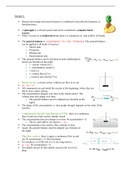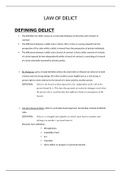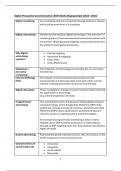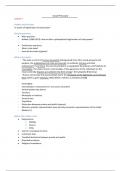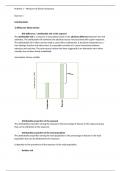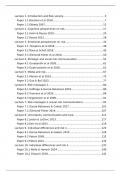Les 1
RNA isolatie HeLa cellen
Tripure: phenol extraction
• Tripure contains monophasic solutions of Phenol and Guanidine Thiocyanate (GITC; a
chaotropic agent).
• The pH of phenol determines the partitioning of DNA and RNA between the organic phase and
the aqueous phase.
• At neutral or slightly alkaline pH (pH 7-8), the phosphate diesters in nucleic acids are
negatively charged, and thus DNA and RNA both partition into the aqueous phase.
• At this acidic pH, most proteins and small DNA fragments (<10 kb) fractionate into the organic
phase and large DNA fragments and some proteins remain at the interphase between the
organic and aqueous phases
Ontstaan van drie fases:
Waterige fase: RNA
Interfase: DNA
Organische fase: eiwitten en vetten
Fenol bindt aan de eiwitten, waardoor na toevoeging van chloroform een
organische fase ontstaat met daarin fenol en eiwitten. (in de bovenste fase juist de nucleinezuren).
Which is the component of Tripure, which causes release of RNA from cells?
Guanidinium thiocyanate
Which is the component of Tripure, which results in stable RNA? How come?
Guanidinium thiocyanate, omdat fenol een OH groep heeft, dat het RNA juist minder stabiel maakt.
RNA Integrity Number (RIN)
• Formule berekent RNA integriteit aan hand van kenmerken in de grafiek
,Het bepalen van de zuiverheid en integriteit van het geïsoleerde RNA is een cruciale stap wil men
betrouwbare en betekenisvolle resultaten verkrijgen betreffende de expressie van bepaalde mRNA-
sequenties. Het is echt van groot belang om zo intact mogelijk RNA te gebruiken voor succesvolle
analysen met Real-time RT-PCR en RT-PCR-array. De 2100 Electrophoresis Bioanalyzer geeft een
visueel beeld weer van de RNA-integriteit. Men verkrijgt voor ieder staal een elektroferogram waarop
eventuele aanwezigheid van RNA-degradatie vastgesteld kan worden. Aan ieder electroferogram
wordt een RIN (RNA Integrity Number)-waarde toegekend. Aan volledig intact RNA wordt een RIN-
waarde van tien toegeschreven. Bij een RINwaarde van zeven of hoger, kan men spreken van een
goede en zuivere RNA-extractie.
RNA integrity can be evaluated by the comparison of 28S and 18S ribosomal RNAs (rRNA) as a
representation of total RNA.
Oligo(dT) primers may be modified to improve efficiency of reverse transcription. For instance, the
length of oligo(dT) primers may be extended to 20 nucleotides or longer to enable their annealing in
reverse transcription reactions at higher temperatures. In some cases, oligo(dT) primers may include
degenerate bases like dN (dA, dT, dG, or dC) and dV (either dG, dA, or dC) at the 3 ′ end. This end. This
modification prevents poly(A) slippage and locks the priming site immediately upstream of the poly(A)
tail. These primers are referred to as anchored oligo(dT).
Random primers are oligonucleotides with random base sequences. They are often six nucleotides
long and are usually referred to as random hexamers, N 6, or dN6. Due to their random binding (i.e., no
template specificity), random primers can potentially anneal to any RNA species in the sample.
Therefore, these primers may be considered for reverse transcription of RNAs without poly(A) tails
(e.g., rRNA, tRNA, non-coding RNAs, small RNAs, prokaryotic mRNA), degraded RNA (e.g., from FFPE
tissue), and RNA with known secondary structures (e.g., viral genomes).
Why is no sequence indicated? – Willekeurig, dus je kan van te voren niet weten welke sequentie het
is.
Bij de realtime-PCR-methode, ook wel kwantitatieve of kinetische PCR-methode (qPCR) genoemd, kan
tijdens de PCR het DNA al worden aangetoond; dit is een snelle methode voor het opsporen
van micro-organismen. Realtime-PCR maakt zowel het aantonen (detectie) als kwantificering van een
of meer specifieke nucleïnezuurvolgorden (sequenties) in het DNA-monster mogelijk.
,The accuracy of the quantitation of gene expression by RT-qPCR depends heavily upon the quality and
quantity of cDNA templates. Thus, the reverse transcription step is critical for success in RT-qPCR. The
reverse transcription step should generate cDNA products that are representative of the original RNA
population. The reverse transcriptase selected should therefore be able to synthesize cDNA efficiently,
even with low-abundance genes and suboptimal and/or challenging RNA samples
Verschil real-time PCR vs real-time (q)PCR
Vanwege de hogere gevoeligheid dan RT-PCR, wordt RT-qPCR ook veel gebruikt om de aanwezigheid
van retrovirussen (RNA-virussen) in onderzoeksmonsters te onderzoeken. Net als bij de RT-PCR-
workflow wordt RNA eerst omgezet in cDNA, dat vervolgens wordt versterkt door PCR. Het
belangrijkste verschil is echter dat niveaus van geamplificeerd cDNA worden gemeten door
fluorescentie in realtime tijdens de exponentiële fase van amplificatie. Het amplificatieniveau wordt
gebruikt als basis om de oorspronkelijke doelen binnen de RNA-populatie te kwantificeren.
Cq (Cp of Ct) waarde is aantal cycli dat nodig is voor signaal > grenswaarde
Real-time PCR principle
• continuous monitoring of PCR product accumulation
i.e. measure every cycle the amount of fluorescence
• relationship between the time fluorescence increases above background and the initial
amount of template
i.e. the sooner fluorescence is visible, the more template was present, and vice versa
Hoe zit het qua verschil endpoint PCR en QPCR?
In endpoint PCR, amplicons are detected when
amplification has reached the plateau phase after PCR. In
real-time PCR, quantitation of amplicons occurs during
the exponential phase.
, Method 1 for determining Cq values: the threshold method
Gelabelde probes binden aan een specifiek stuk DNA en zijn niet waar te nemen als de probe intact is.
Zodra de polymerasekettingreactie op gang komt, wordt de probe afgebroken en wordt het label
zichtbaar. Fluorescerende labels gaan licht van een bepaalde golflengte uitzenden. Hoe meer DNA
wordt omgezet, des te sterker het signaal. Dat signaal, uitgedrukt in RFU's (Relative Fluorescent Unit),
wordt grafisch uitgezet tegen de thresholdcyclus (drempelwaarde, aangeduid met Ct-waarde), de
cyclus in het PCR-proces waarbij de excitatie van het licht dat vrijkomt van het label boven de
detectiegrens uitkomt. Omdat er bij qPCR's ook standaarden worden meegenomen waarvan de
hoeveelheid DNA bekend is, kan er een ijklijn worden geplot. Uit deze lineaire grafiek wordt de
hoeveelheid DNA berekend, door de thresholdcyclus af te zetten tegen de excitatie.
Method 2 for determining Cq values: the 2nd derivative maximum method (PC Practicum!!)
The automated method identifies the crossing
point of a sample, i.e. where the fluorescence
curve of the sample turns sharply upward. This
turning point will be a maximum on the second
derivative plot of the reaction.
This method allows you to use internal controls.
Comparative Cq quantification method
In the comparative or ΔΔCt method of qPCR data analysis, the Ct
values obtained from two different experimental RNA samples are
directly normalized to a housekeeping gene and then compared. This
method assumes that the amplification efficiencies of the gene of
interest and the housekeeping genes are close to 100 percent
(meaning a standard or calibration curve slope of -3.32) First, the
difference between the Ct values (ΔCt) of the gene of interest and the
housekeeping gene is calculated for each experimental sample. Then,
the difference in the ΔCt values between the experimental and
control samples ΔΔCt is calculated. The fold-change in expression of
the gene of interest between the two samples is then equal to 2^(-
ΔΔCt).


